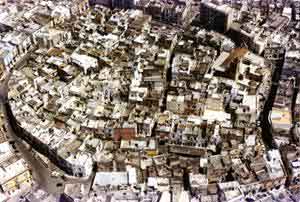 The attempts of this laboratory to identify an urban planning methodology, in over twenty years of research, have been many, but always with poor results. Undoubtedly a not negligible turning point was impressed by the participation in the neighborhood laboratory of Otranto, in 1980. The idea of a diagnostic center and a neighborhood documentation center, with the participation of the inhabitants and the direction of the architect-conduit, seemed like an excellent idea, but after twenty years, it remained a simple proposal that was difficult to implement. In the belief that the age appropriate for any type of literacy should not exceed fifteen years and after the successful outcome of the experimentation at the "Balilla" primary school, with the Ce.IPE project an attempt was made to start, at the elementary and middle schools of the historic center, the < A HREF = "# relief" onClick = "exhibition (6)"> training of inhabitants who could collaborate with the neighborhood documentation center.
The attempts of this laboratory to identify an urban planning methodology, in over twenty years of research, have been many, but always with poor results. Undoubtedly a not negligible turning point was impressed by the participation in the neighborhood laboratory of Otranto, in 1980. The idea of a diagnostic center and a neighborhood documentation center, with the participation of the inhabitants and the direction of the architect-conduit, seemed like an excellent idea, but after twenty years, it remained a simple proposal that was difficult to implement. In the belief that the age appropriate for any type of literacy should not exceed fifteen years and after the successful outcome of the experimentation at the "Balilla" primary school, with the Ce.IPE project an attempt was made to start, at the elementary and middle schools of the historic center, the < A HREF = "# relief" onClick = "exhibition (6)"> training of inhabitants who could collaborate with the neighborhood documentation center.
Here we will begin with the examination of some student experiences, which have served to demonstrate how much the urban importance is a living entity, demanding continuous updating:
1) il historic center of Monopoli (BA) , in the analysis carried out by a group of students of the thematic cartography course of the Faculty of Architecture of Bari, in the academic year 1993/94. At the time, the laboratory did not have an Internet site and, for multimedia presentation, programming with HyperCard was used. By renouncing the visual and sound effects of this language, we can examine the work, as it results from the transfer onto the Internet;
2) il historic center of Bitritto (BA) , subject, in the current academic year, of the year theme of Sante Consiglio , student of the photogrammetric survey of architecture course;
2) il historic center of MartinaFranca (TA) , subject, in the current academic year, of the year theme of Elisabetta Fedele , student of the course of photogrammetric survey of architecture , who has ventured in the remote updating of the documentation sheet.
3) il center of Giovinazzo (BA) , analyzed for the purpose of inserting a new architectural body;
The analysis of these works leads to a simple conclusion: the urban survey cannot be entrusted to a group of people, who claim to carry out this work in a limited time. The aim of this research is the creation of a virtual documentation center, intended to store and make the documentation of an urban center available on the Internet, made available by the Community. It is obviously a question of triggering a production process that can be fueled by the most varied interests. At first glance there seems to be nothing new: in fact there has been a lot of talk and we continue to talk about "virtual city", but almost always it was a top-down organization with a profit-making background, which has nipped cultural interests.
The basic idea is to assign a free web space to each house number, which can be managed independently. With an adequate awareness campaign, the much vaunted virtual city will be able to be born and grow with criteria that are not very different from the real one.
Given that there are already many initiatives in the sector: it will be a matter of coordinating them with a simple census, in which schools of all levels and degrees can be involved, starting with elementary ones. It should not be forgotten that for each house number there is at least one student, who will be able to exhibit on the internet, for example, the shop or the shop of his father or of some partner. Initially he will limit himself to putting some photos, but over time, when he will have learned to read and write with hypertext languages, he will be able to visit the store in a virtual way, examine the individual products with their prices and, who knows, even order via network.